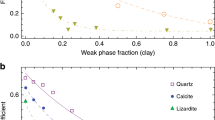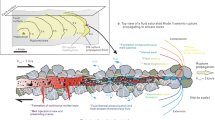Abstract
The determination of rock friction at seismic slip rates (about 1 m s−1) is of paramount importance in earthquake mechanics, as fault friction controls the stress drop, the mechanical work and the frictional heat generated during slip1. Given the difficulty in determining friction by seismological methods1, elucidating constraints are derived from experimental studies2,3,4,5,6,7,8,9. Here we review a large set of published and unpublished experiments (∼300) performed in rotary shear apparatus at slip rates of 0.1–2.6 m s−1. The experiments indicate a significant decrease in friction (of up to one order of magnitude), which we term fault lubrication, both for cohesive (silicate-built4,5,6, quartz-built3 and carbonate-built7,8) rocks and non-cohesive rocks (clay-rich9, anhydrite, gypsum and dolomite10 gouges) typical of crustal seismogenic sources. The available mechanical work and the associated temperature rise in the slipping zone trigger11,12 a number of physicochemical processes (gelification, decarbonation and dehydration reactions, melting and so on) whose products are responsible for fault lubrication. The similarity between (1) experimental and natural fault products and (2) mechanical work measures resulting from these laboratory experiments and seismological estimates13,14 suggests that it is reasonable to extrapolate experimental data to conditions typical of earthquake nucleation depths (7–15 km). It seems that faults are lubricated during earthquakes, irrespective of the fault rock composition and of the specific weakening mechanism involved.
This is a preview of subscription content, access via your institution
Access options
Subscribe to this journal
Receive 51 print issues and online access
$199.00 per year
only $3.90 per issue
Buy this article
- Purchase on Springer Link
- Instant access to full article PDF
Prices may be subject to local taxes which are calculated during checkout




Similar content being viewed by others
References
Scholz, C. H. The Mechanics of Earthquakes and Faulting (Cambridge Univ. Press, 2002)
Goldsby, D. L. & Tullis, T. E. Low frictional strength of quartz rocks at subseismic slip rates. Geophys. Res. Lett. 29, 1844 (2002)
Di Toro, G., Goldsby, D. L. & Tullis, T. E. Friction falls towards zero in quartz rock as slip velocity approaches seismic rates. Nature 427, 436–439 (2004)
Di Toro, G. & Hirose, T. Nielsen, S. Pennacchioni, G. & Shimamoto, T. Natural and experimental evidence of melt lubrication of faults during earthquakes. Science 311, 647–649 (2006)
Hirose, T. & Shimamoto, T. Growth of molten zone as a mechanism of slip weakening of simulated faults in gabbro during frictional melting. J. Geophys. Res. 110, B05202 (2005)
Nielsen, S., Di Toro, G., Hirose, T. & Shimamoto, T. Frictional melt and seismic slip. J. Geophys. Res. 113, B01308 (2008)
Han, R., Shimamoto, T., Hirose, T., Ree, J.-H. & Ando, J. Ultralow friction of carbonate faults caused by thermal decomposition. Science 316, 878–881 (2007)
Han, R., Hirose, T. & Shimamoto, T. Strong velocity weakening and powder lubrication of simulated carbonate faults at seismic slip rates. J. Geophys. Res. 115, B03412 (2010)
Mizoguchi, K., Hirose, T., Shimamoto, T. & Fukuyama, E. High-velocity frictional behavior and microstructure evolution of fault gouge obtained from Nojima fault, southwest Japan. Tectonophysics 471, 285–296 (2009)
De Paola, N. et al. Fault lubrication and earthquake propagation in thermally unstable rocks. Geology 39, 35–38 (2011)
Fox, P. G. Mechanically initiated chemical reactions in solids. J. Mater. Sci. 10, 340–360 (1975)
Fisher, T. E. Tribochemistry. Annu. Rev. Mater. Sci. 18, 303–323 (1988)
Cocco, M. & Tinti, E. Scale dependence in the dynamics of earthquake propagation: evidence from seismological and geological observations. Earth Planet. Sci. Lett. 273, 123–131 (2008)
Rice, J. R. Heating and weakening of faults during earthquake slip. J. Geophys. Res. 111, B05311 (2006)
Byerlee, J. D. Friction of rocks. Pure Appl. Geophys. 116, 615–626 (1978)
Brace, W. F. & Byerlee, J. D. Stick slip as a mechanism for earthquakes. Science 168, 990–992 (1966)
Scholz, C. H. Earthquakes and friction laws. Nature 391, 37–42 (1998)
Marone, C. Laboratory-derived friction laws and their application to seismic faulting. Annu. Rev. Earth Planet. Sci. 26, 643–696 (1998)
Dieterich, J. H. Modeling of rock friction 1. Experimental results and constitutive equations. J. Geophys. Res. 84, 2161–2168 (1979)
Heaton, T. H. Evidence for and implications of self healing pulses of slip in earthquake rupture. Phys. Earth Planet. Inter. 64, 1–20 (1990)
Hirono, T. et al. A chemical kinetic approach to estimate dynamic shear stress during the 1999 Taiwan Chi-Chi earthquake. Geophys. Res. Lett. 34, L19308 (2007)
Sibson, R. H. Generation of pseudotachylyte by ancient seismic faulting. Geophys. J. R. Astron. Soc. 43, 775–794 (1975)
Di Toro, G., Hirose, T., Nielsen, S. & Shimamoto, T. in Radiated Energy and the Physics of Faulting (eds Abercrombie, R., McGarr, A., Di Toro, G. & Kanamori, H. ) 121–134 (Geophys. Monogr. Ser. 170, American Geophysical Union, 2006)
Heinicke, G. Tribochemistry (Carl-Hanser, 1984)
Hsu, S. M., Zhang, J. & Yin, Z. The nature and origin of tribochemistry. Tribol. Lett. 13, 131–139 (2002)
Steinike, U. & Tkácˇová, K. Mechanochemistry of solids—real structure and reactivity. J. Mater. Synth. Process. 8, 197–203 (2000)
Balázˇ, P. Mechanochemistry in Nanoscience and Minerals Engineering (Springer, 2008)
Beeler, N. M., Tullis, T. E. & Goldsby, D. L. Constitutive relationships and physical basis of fault strength due to flash heating. J. Geophys. Res. 113, B01401 (2008)
Reches, Z. & Lockner, D. A. Fault weakening and earthquake instability by powder lubrication. Nature 467, 452–455 (2010)
Noda, H., Dunham, E. M. & Rice, J. R. Earthquake ruptures with thermal weakening and the operation of major faults at low overall stress levels. J. Geophys. Res. 114, B07302 (2009)
Ma, K. F. et al. Slip zone and energetics of a large earthquake from the Taiwan Chelungpu-fault Drilling Project (TCDP). Nature 444, 473–476 (2006)
Brantut, N., Schubnel, A., Rouzaud, J.-N., Brunet, F. & Shimamoto, T. High-velocity frictional properties of a clay bearing fault gouge and implications for earthquake mechanics. J. Geophys. Res. 113, B10401 (2008)
Yuan, F. & Prakash, V. Use of a modified torsional Kolsky bar to study frictional slip resistance in rock-analog materials at coseismic slip rates. Int. J. Solids Struct. 45, 4247–4263 (2008)
Carslaw, H. S. & Jaeger, J. C. Conduction of Heat in Solids 2nd edn, 76 (Clarendon, 1959)
Mizoguchi, K., Hirose, T., Shimamoto, T. & Fukuyama, E. Reconstruction of seismic faulting by high-velocity friction experiments: an example of the 1995 Kobe earthquake. Geophys. Res. Lett. 34, L01308 (2007)
Shimamoto, T. & Tsutsumi, A. A new rotary-shear high-speed frictional testing machine: its basic design and scope of research [in Japanese with English abstract]. J. Tecton. Res. Group Jpn 39, 65–78 (1994)
Acknowledgements
G.D.T. thanks T. Tullis and D. Goldsby for introducing him to this topic. G.D.T. was supported by a Progetti di Eccellenza Fondazione Cassa di Risparmio di Padova e Rovigo and by European Research Council Starting Grant Project 205175.
Author information
Authors and Affiliations
Contributions
G.D.T. wrote the paper. S.N. wrote the Methods. Original and unpublished experimental work reported in the paper: N.D.P., R.H., F.F., G.D.T., T.H. and K.M. Concept development: G.D.T., R.H., S.N., M.C., N.D.P., T.H. and T.S.
Corresponding author
Ethics declarations
Competing interests
The authors declare no competing financial interests.
Supplementary information
Supplementary Information
The file contains Supplementary Sections 1-5, comprising Supplementary Text, Supplementary Figures with legends, Supplementary Tables and additional references. (PDF 1728 kb)
Rights and permissions
About this article
Cite this article
Di Toro, G., Han, R., Hirose, T. et al. Fault lubrication during earthquakes. Nature 471, 494–498 (2011). https://doi.org/10.1038/nature09838
Received:
Accepted:
Published:
Issue Date:
DOI: https://doi.org/10.1038/nature09838
This article is cited by
-
Progress in modeling the Tohoku-oki megathrust earthquake cycle and associated crustal deformation processes
Progress in Earth and Planetary Science (2023)
-
Thermoelastic instability on a frictional surface and its implication for size effect in friction experiments
Earth, Planets and Space (2023)
-
Physical state of water controls friction of gabbro-built faults
Nature Communications (2023)
-
The physical mechanisms of induced earthquakes
Nature Reviews Earth & Environment (2023)
-
Dynamics between earthquakes, volcanic eruptions, and geothermal energy exploitation in Japan
Scientific Reports (2023)
Comments
By submitting a comment you agree to abide by our Terms and Community Guidelines. If you find something abusive or that does not comply with our terms or guidelines please flag it as inappropriate.



